Ancient greek coins NGC VF Xerxes Artaxerxes I Achaemenid Silver Siglos A1133
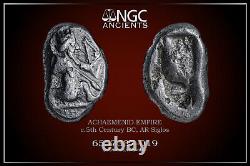
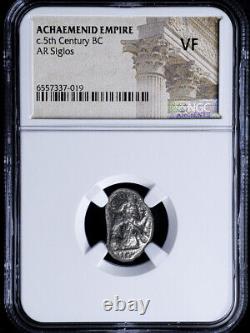

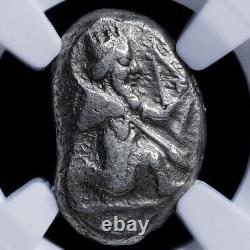
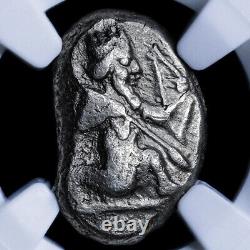
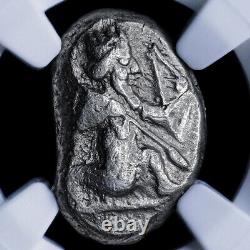
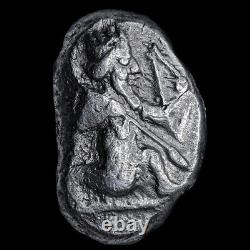
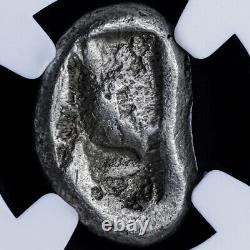

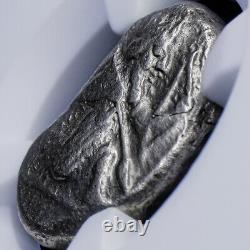
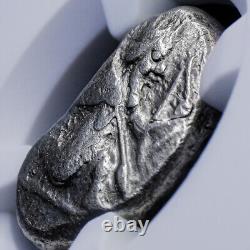
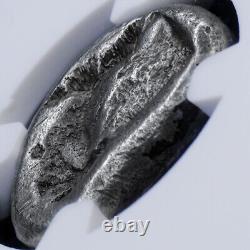
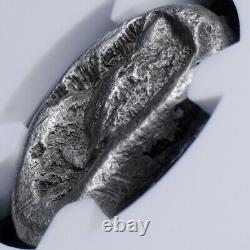
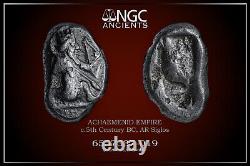

See my other items here. ATTENTION: Dear Customers, you will receive exactly the same item which you see on the pictures, not similar or other. Please read the description carefully and review the photos. For other uses, see Persian Empire (disambiguation). Standard of Cyrus the Great.
The Achaemenid Empire at its greatest territorial extent, under the rule of Darius I. (522 BC to 486 BC). King or King of Kings. The Empire', also called the First Persian Empire, was an ancient Iranian.Empire that was based in Western Asia. And founded by Cyrus the Great. It reached its greatest extent under Xerxes I.
Who conquered most of northern and central ancient Greece. At its greatest territorial extent, the Achaemenid Empire stretched from the Balkans. In the west to the Indus Valley.The empire was larger than any previous empire. In history, spanning a total of 5.5 million square kilometers (2.1 million square miles). The empire had its beginnings in the 7th century BC, when the Persians. Settled in the southwestern portion of the Iranian Plateau.
In the region of Persis. From this region, Cyrus rose and defeated the Median Empire. Of which he had previously been king-as well as Lydia. Following which he formally established the Achaemenid Empire. The Achaemenid Empire is known for imposing a successful model of centralized, bureaucratic administration via the use of satraps.
Its multicultural policy; building infrastructure, such as road systems. The use of an official language across its territories; and the development of civil services, including its possession of a large, professional army. The empire's successes inspired the usage of similar systems in later empires.
An ardent admirer of Cyrus the Great, conquered most of the Achaemenid Empire by 330 BC. Upon Alexander's death, most of the former territory of the empire fell to the rule of the Ptolemaic Kingdom.The Iranian elites of the central plateau reclaimed power by the 2nd century BC under the Parthian Empire. Means "of the family of the Achaemenis/Achaemenes" Old Persian. Compound translating to "having a friend's mind". Was himself a minor seventh-century ruler of the Anshan. In southwestern Iran, and a vassal of Assyria.
Around 850 BC the original nomadic people who began the empire called themselves the Parsa and their constantly shifting territory Parsua, for the most part localized around Persis. The name "Persia" is a Greek and Latin. Pronunciation of the native word referring to the country of the people originating from Persis. , meaning "The Empire" was used by the Achaemenids to refer to their multinational state. Dates are approximate, consult particular article for details.Family tree of the Achaemenid rulers. The Persian nation contains a number of tribes as listed here.
Upon which all the other tribes are dependent. Of these, the Pasargadae are the most distinguished; they contain the clan of the Achaemenids from which spring the Perseid kings. Other tribes are the Panthialaei. All of which are attached to the soil, the remainder-the Dai.
The Achaemenid Empire was created by nomadic Persians. The Persians were an Iranian people. Who arrived in what is today Iran. 1000 BC and settled a region including north-western Iran, the Zagros Mountains. For a number of centuries they fell under the domination of the Neo-Assyrian Empire.
(911-609 BC), based in northern Mesopotamia. The Persians were originally nomadic pastoralists. In the western Iranian Plateau. The Achaemenid Empire was not the first Iranian empire, as the Medes. Another group of Iranian peoples, established a short-lived empire and played a major role in the overthrow of the Assyrians. The Achaemenids were initially rulers of the Elamite city of Anshan. Near the modern city of Marvdasht. The title "King of Anshan" was an adaptation of the earlier Elamite title "King of Susa and Anshan". There are conflicting accounts of the identities of the earliest Kings of Anshan. According to the Cyrus Cylinder.(the oldest extant genealogy of the Achaemenids) the kings of Anshan were Teispes. Also known as Cyrus the Great, who created the empire the later Behistun Inscription. Written by Darius the Great.
Claims that Teispes was the son of Achaemenes. And that Darius is also descended from Teispes through a different line, but no earlier texts mention Achaemenes. He writes that Cyrus the Great was the son of Cambyses I and Mandane of Media. The king of the Median Empire.
Further information: Battle of the Persian Border. Achaemenid invasion of the Indus Valley. And European Scythian campaign of Darius I.
Map of the expansion process of Achaemenid territories. Cyrus revolted against the Median Empire in 553 BC, and in 550 BC succeeded in defeating the Medes, capturing Astyages and taking the Median capital city of Ecbatana.
Once in control of Ecbatana, Cyrus styled himself as the successor to Astyages and assumed control of the entire empire. By inheriting Astyages' empire, he also inherited the territorial conflicts the Medes had had with both Lydia. Of Lydia sought to take advantage of the new international situation by advancing into what had previously been Median territory in Asia Minor. Cyrus led a counterattack which not only fought off Croesus' armies, but also led to the capture of Sardis.
And the fall of the Lydian Kingdom in 546 BC. In charge of collecting tribute in Lydia and left, but once Cyrus had left Pactyes instigated a rebellion against Cyrus. Cyrus sent the Median general Mazares. To deal with the rebellion, and Pactyes was captured. Mazares, and after his death Harpagus.
Set about reducing all the cities which had taken part in the rebellion. The subjugation of Lydia took about four years in total.
When the power in Ecbatana changed hands from the Medes to the Persians, many tributaries to the Median Empire believed their situation had changed and revolted against Cyrus. This forced Cyrus to fight wars against Bactria. During these wars, Cyrus established several garrison towns in Central Asia, including the Cyropolis.Is said, in the Bible, to have liberated the Hebrew. To resettle and rebuild Jerusalem. Earning him an honored place in Judaism. Nothing is known of Persian-Babylonian relations between 547 BC and 539 BC, but it is likely that there were hostilities between the two empires for several years leading up to the war of 540-539 BC and the Fall of Babylon. In October 539 BC, Cyrus won a battle against the Babylonians at Opis.
Without a fight before finally capturing the city of Babylon. On 12 October, where the Babylonian king Nabonidus. Upon taking control of the city, Cyrus depicted himself in propaganda as restoring the divine order which had been disrupted by Nabonidus, who had promoted the cult of Sin. And he also portrayed himself as restoring the heritage of the Neo-Assyrian Empire.
By comparing himself to the Assyrian king Ashurbanipal. Also unreservedly praises Cyrus for his actions in the conquest of Babylon, referring to him as Yahweh. He is credited with freeing the people of Judah. From their exile and with authorizing the reconstruction of much of Jerusalem.
The tomb of Cyrus the Great. Founder of the Achaemenid Empire. In 530 BC, Cyrus presumably died while on a military expedition against the Massagetae. He was succeeded by his eldest son Cambyses II. While his younger son Bardiya. Received a large territory in Central Asia.By 525 BC, Cambyses had successfully subjugated Phoenicia. And was making preparations to invade Egypt. With the newly created Persian navy. The great Pharaoh Amasis II.
Had died in 526 BC and had been succeeded by Psamtik III. Resulting in the defection of key Egyptian allies to the Persians. Psamtik positioned his army at Pelusium. He was soundly defeated by the Persians in the Battle of Pelusium.Where the Persians defeated him and took him prisoner. Herodotus depicts Cambyses as openly antagonistic to the Egyptian people and their gods, cults, temples, and priests, in particular stressing the murder of the sacred bull Apis. He says that these actions led to a madness that caused him to kill his brother Bardiya (who Herodotus says was killed in secret), his own sister-wife.
He then concludes that Cambyses completely lost his mind, and all later classical authors repeat the themes of Cambyses' impiety and madness. However, this is based on spurious information, as the epitaph of Apis from 524 BC shows that Cambyses participated in the funeral rites of Apis styling himself as pharaoh.Following the conquest of Egypt, the Libyans. And the Greeks of Cyrene. In present-day eastern Libya Cyrenaica. Surrendered to Cambyses and sent tribute without a fight. Cambyses then planned invasions of Carthage.
The oasis of Ammon and Ethiopia. Herodotus claims that the naval invasion of Carthage was canceled because the Phoenicians, who made up a large part of Cambyses' fleet, refused to take up arms against their own people, but modern historians doubt whether an invasion of Carthage was ever planned at all. However, Cambyses dedicated his efforts to the other two campaigns, aiming to improve the Empire's strategic position in Africa by conquering the Kingdom of Meroë. And taking strategic positions in the western oases. To this end, he established a garrison at Elephantine. Consisting mainly of Jewish soldiers, who remained stationed at Elephantine throughout Cambyses' reign. The invasions of Ammon and Ethiopia themselves were failures. Herodotus claims that the invasion of Ethiopia was a failure due to the madness of Cambyses and the lack of supplies for his men, but archaeological evidence suggests that the expedition was not a failure, and a fortress at the Second Cataract of the Nile. On the border between Egypt and Kush, remained in use throughout the Achaemenid period.The events surrounding Cambyses' death and Bardiya's succession are greatly debated as there are many conflicting accounts. According to Herodotus, as Bardiya's assassination had been committed in secret, the majority of Persians still believed him to be alive. To rise up against Cambyses, with one of them sitting on the throne able to impersonate Bardiya because of their remarkable physical resemblance and shared name (Smerdis in Herodotus' accounts).
Writes that when Cambyses had Bardiya killed he immediately put the magus Sphendadates in his place as satrap of Bactria due to a remarkable physical resemblance. Two of Cambyses' confidants then conspired to usurp Cambyses and put Sphendadates on the throne under the guise of Bardiya. According to the Behistun Inscription. Written by the following king Darius the Great. A magus named Gaumata impersonated Bardiya and incited a revolution in Persia.
Whatever the exact circumstances of the revolt, Cambyses heard news of it in the summer of 522 BC and began to return from Egypt, but he was wounded in the thigh in Syria and died of gangrene, so Bardiya's impersonator became king. The account of Darius is the earliest, and although the later historians all agree on the key details of the story, that a magus impersonated Bardiya and took the throne, this may have been a story created by Darius to justify his own usurpation.
Hypothesises that Bardiya was not killed by Cambyses, but waited until his death in the summer of 522 BC to claim his legitimate right to the throne as he was then the only male descendant of the royal family. Briant says that although the hypothesis of a deception by Darius is generally accepted today, "nothing has been established with certainty at the present time, given the available evidence". The Achaemenid Empire at its greatest extent, c. Gaumata ruled for seven months before being overthrown in 522 BC by Darius the Great. (Darius I) (Old Persian Daryavus, "who holds firm the good", also known as Darayarahush).
The Magi, though persecuted, continued to exist, and a year following the death of the first pseudo-Smerdis (Gaumata), saw a second pseudo-Smerdis (named Vahyazdata) attempt a coup. The coup, though initially successful, failed. Writes that the native leadership debated the best form of government for the empire.
Surrendered his country to the Persians in about 512-511, Macedonians and Persians were strangers no more as well. Was part of Persian military operations initiated by Darius the Great. (521-486) in 513-after immense preparations-a huge Achaemenid army invaded the Balkans. Roaming to the north of the Danube.Darius' army subjugated several Thracian peoples. And virtually all other regions that touch the European part of the Black Sea. Such as parts of nowadays Bulgaria. Darius left in Europe one of his commanders named Megabazus.
Whose task was to accomplish conquests in the Balkans. The Persian troops subjugated gold-rich Thrace. The coastal Greek cities, and defeated and conquered the powerful Paeonians. Finally, Megabazus sent envoys to Amyntas, demanding acceptance of Persian domination, which the Macedonians did. The Balkans provided many soldiers for the multi-ethnic Achaemenid army.
Many of the Macedonian and Persian elite intermarried, such as the Persian official Bubares. Who married Amyntas' daughter, Gygaea.Family ties the Macedonian rulers Amyntas and Alexander enjoyed with Bubares ensured them good relations with the Persian kings Darius and Xerxes the Great. The Persian invasion led indirectly to Macedonia's rise in power and Persia had some common interests in the Balkans; with Persian aid, the Macedonians stood to gain much at the expense of some Balkan tribes such as the Paeonians and Greeks. All in all, the Macedonians were willing and useful Persian allies.
Macedonian soldiers fought against Athens and Sparta. In Xerxes the Great's army. The Persians referred to both Greeks and Macedonians as Yauna. ", their term for "Greeks", and to Macedonians specifically as Yaunã Takabara or "Greeks with hats that look like shields, possibly referring to the Macedonian kausia.Daughter of Cyrus the Great. S wife, and mother of Xerxes the Great. By the 5th century BC, the Kings of Persia were either ruling over or had subordinated territories encompassing not just all of the Persian Plateau.
And all of the territories formerly held by the Assyrian Empire. , but beyond this all of Anatolia.
As well as the Southern Caucasus. And parts of the North Caucasus. To the north and west, most of the Black Sea. Coastal regions, parts of Central Asia. As far as the Aral Sea.
To the north and north-east, the Hindu Kush. And the western Indus basin.
Corresponding to modern Afghanistan and Pakistan. To the far east, parts of northern Arabia. To the south, and parts of eastern Libya. To the south-west, and parts of Oman.

